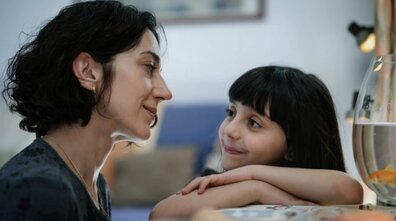
Shayda
Studio: UTA
Director: Noora Niasari
Jan 27, 2023
Web Exclusive
![]()
Shayda is a heart-wrenching, if not somewhat familiar, tale about a woman trying to escape abuse and create a better life for herself and her child.
Set in 1995, the film follows Shayda (Zar Amir Ebrahimi), an Iranian single mother living in Australia with her young daughter Mona (Selina Zahednia). Staying at a shelter home for victims of abuse, Shayda spends her days caring for Mona, preparing for a custody battle against her husband, Hossein (Osamah Sami), and trying to retain Iranian traditions to stay connected to her native culture. As Shayda prepares to celebrate the Persian New Year (Nowruz), she learns that a judge has granted Hossein the right to have custody of Mona for a couple of hours each week. This new situation, and her past trauma, complicate her battle to create a safe space for herself and her daughter.
From there, the film oscillates between several different plotlines. These include Shayda’s and Hossein’s interactions when they exchange Mona, where he often abuses her emotionally and physically, as well as Shayda’s interactions with other Iranians in her town, who often judge her behind her back or even to her face. All of these threads show the multifaceted nature of Shayda’s character, explaining how her fight is more than just guaranteeing her safety; it is about discovering her identity.
Since Shayda isn’t anchored by a single narrative, it feels more like a slice-of-life story. The film bounces rapidly from one plotline to another, painting a complete portrait of Shayda’s daily routine. This element has its benefits and its drawbacks. By showing so many different aspects of Shayda’s life, as well as the ways that she reacts to these situations, viewers gain a complete understanding of the character’s emotions and motivations, making it easier to connect with her in the process. When the film eventually uses the character to showcase and comment on a variety of themes–most notably, trauma and cultural identity–these ideas feel well-thought-out and well-explored throughout the story.
At the same time, the repetition of plotlines tends to make the film feel redundant and overcooked since viewers must constantly revisit scenes that mimic one another in style, narrative and tone. The film’s two-hour runtime only adds to this issue, as the inclusion of so many sequences with similar aspects causes the film to appear directionless for far too long. As such, when the credits roll, viewers are left remembering the film’s larger moments but not much else.
While Shayda’s entire ensemble is spectacular, the film belongs to Ebrahimi. The entire film hinges on her performance, and the actress completely delivers, sinking into her character with an unnerving level of ease. Right from the opening, it becomes clear that her multi-layered performance is the film’s beating heart, selling the story at places where the script cannot and constantly commanding the audience’s complete attention. (festival.sundance.org)
Author rating: 6/10
Average reader rating: 0/10
Most Recent
- Premiere: Mia Day Shares New Single “Mountain Song” (News) — Mia Day
- Tallinn Music Week, Tallinn, Estonia, April 3-7, 2024 (Review) — Virta, Musta Huone, Mari Kalkun, Sven Grünberg
- Picnic at Hanging Rock [4K UHD] (Review) —
- Joe Goddard of Hot Chip Announces New Album, Shares Video for New Song “Moments Die” (Feat. Barrie) (News) — Joe Goddard, Hot Chip
- Premiere: O Slow Shares New EP ‘Every Time I Look In The Mirror’ (News) — O Slow


Comments
Submit your comment
There are no comments for this entry yet.